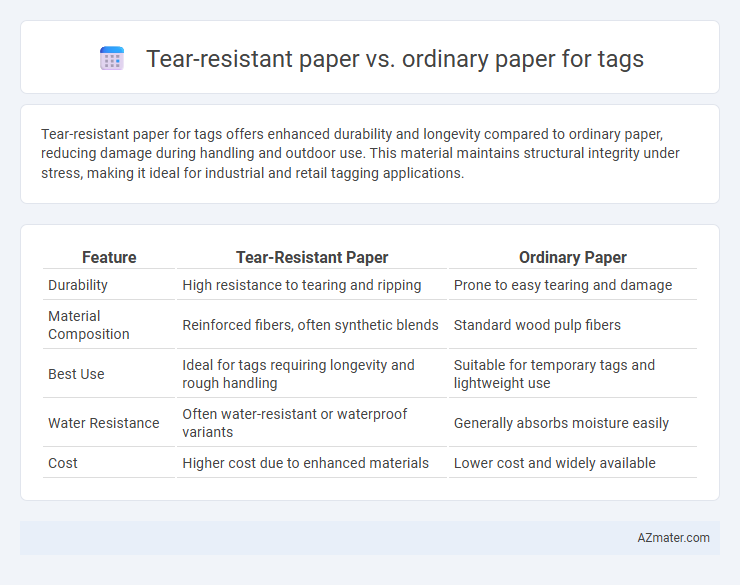Tear-resistant paper for tags offers enhanced durability and longevity compared to ordinary paper, reducing damage during handling and outdoor use. This material maintains structural integrity under stress, making it ideal for industrial and retail tagging applications.
Table of Comparison
| Feature | Tear-Resistant Paper | Ordinary Paper |
|---|---|---|
| Durability | High resistance to tearing and ripping | Prone to easy tearing and damage |
| Material Composition | Reinforced fibers, often synthetic blends | Standard wood pulp fibers |
| Best Use | Ideal for tags requiring longevity and rough handling | Suitable for temporary tags and lightweight use |
| Water Resistance | Often water-resistant or waterproof variants | Generally absorbs moisture easily |
| Cost | Higher cost due to enhanced materials | Lower cost and widely available |
Introduction to Tag Materials
Tear-resistant paper offers enhanced durability and strength compared to ordinary paper, making it ideal for tags exposed to rough handling or outdoor conditions. This type of paper resists tearing, creasing, and moisture, ensuring that tags remain legible and intact throughout their lifecycle. Ordinary paper, in contrast, lacks these protective qualities, often resulting in compromised tag integrity during shipping, retail, or industrial use.
What Is Tear-Resistant Paper?
Tear-resistant paper is specially engineered with high durability fibers and synthetic coatings to withstand ripping and tearing, making it ideal for tags exposed to rough handling or outdoor conditions. Ordinary paper lacks these reinforced properties, resulting in lower strength and quick deterioration under stress. This makes tear-resistant paper the preferred choice for tags needing longevity and resilience in demanding environments.
Ordinary Paper: Composition and Uses
Ordinary paper for tags is primarily composed of cellulose fibers derived from wood pulp, making it cost-effective and widely available. This type of paper is commonly used for temporary or lightweight tagging applications such as price labels, product information tags, and promotional labels. While ordinary paper is suitable for indoor use and short-term purposes, it lacks the durability and tear resistance required for tags exposed to rough handling or outdoor environments.
Durability Comparison: Tear-Resistant vs Ordinary Paper
Tear-resistant paper exhibits significantly higher durability than ordinary paper, making it ideal for tags subjected to rough handling and environmental stress. Engineered with reinforced fibers, tear-resistant paper withstands ripping and fraying, extending the lifespan of tags in industrial and outdoor settings. Ordinary paper, lacking these reinforced properties, degrades quickly and is prone to tearing, limiting its usefulness for long-term or heavy-duty tagging applications.
Application Suitability for Tags
Tear-resistant paper offers superior durability and longevity for tags used in industrial, outdoor, or heavy-duty environments where frequent handling or exposure to harsh conditions occurs. Ordinary paper is suitable for tags in short-term or low-stress applications, such as retail price labels or office organization, where resistance to tearing is less critical. Choosing tear-resistant paper enhances tag readability and integrity, reducing replacement frequency and improving overall operational efficiency.
Cost Analysis: Tear-Resistant vs Ordinary Paper
Tear-resistant paper costs more upfront compared to ordinary paper due to its durable materials and manufacturing process. However, the higher initial expense often results in long-term savings by reducing tag replacements and minimizing damage-related losses. Ordinary paper may have lower initial costs but can incur frequent expenses from tearing, reprinting, and labor for tag replacement.
Print Quality and Label Appearance
Tear-resistant paper for tags offers superior print quality due to its durable surface that resists smudging and fading, ensuring sharp and vibrant text or graphics. This type of paper maintains a clean, professional appearance longer than ordinary paper, which often warps or tears easily, degrading the label's legibility and aesthetic appeal. Enhanced durability of tear-resistant labels safeguards brand presentation in various environmental conditions, providing consistent clarity and readability.
Environmental Impact and Sustainability
Tear-resistant paper for tags significantly reduces waste due to its durability and extended lifespan compared to ordinary paper, which often requires frequent replacement. This longevity minimizes resource consumption and lowers the environmental footprint associated with paper production and disposal. Choosing tear-resistant paper supports sustainability by decreasing deforestation, water use, and chemical processing linked to standard paper manufacturing.
User Experience and Practical Considerations
Tear-resistant paper used for tags significantly enhances durability, preventing damage from frequent handling and exposure to environmental factors such as moisture and rough surfaces. This robustness ensures tags remain intact and legible for extended periods, improving user experience by maintaining clear information and reducing the need for frequent replacements. In contrast, ordinary paper tags are prone to tearing and wear, which can lead to frustration and increased operational costs due to constant re-tagging.
Conclusion: Choosing the Right Paper for Tags
Tear-resistant paper offers superior durability and longevity compared to ordinary paper, making it ideal for tags exposed to frequent handling or harsh conditions. Ordinary paper is suitable for short-term or low-stress applications where cost-efficiency is prioritized over durability. Selecting the right paper depends on the specific use case, balancing the need for strength with budget and environmental considerations.

Infographic: Tear-resistant paper vs Ordinary paper for Tag
 azmater.com
azmater.com